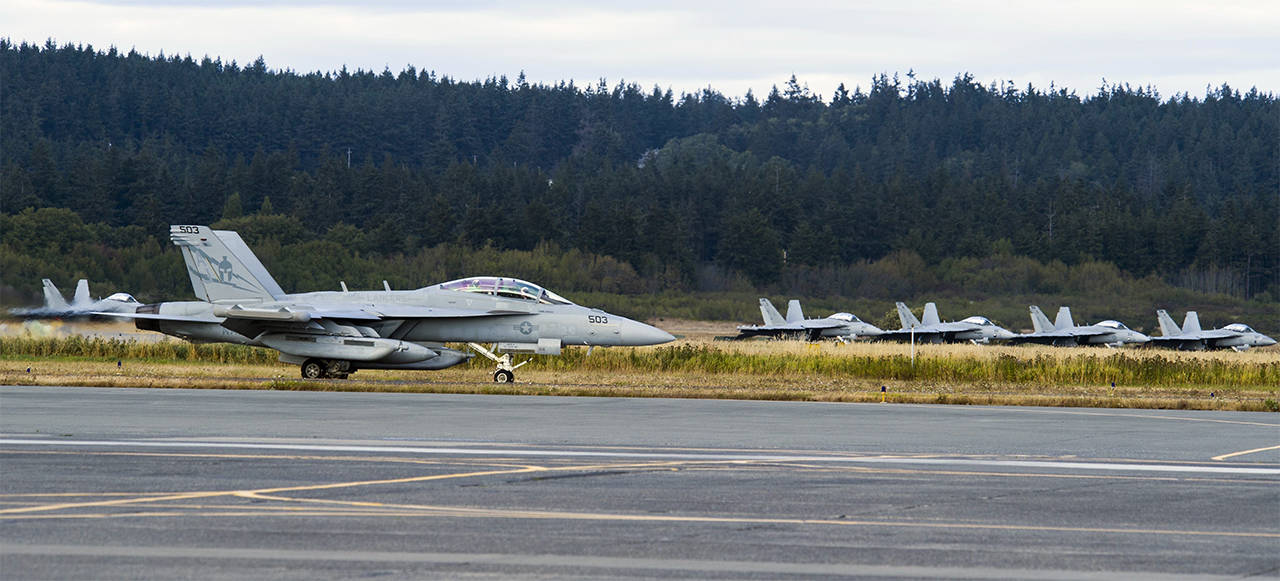A new and first-of-its-kind study of underwater noise from EA-18G Growler aircraft in the water off of Whidbey Islnad found that the sound levels are higher than the thresholds known to disturb orcas and other endangered marine animals.
The peer-reviewed study, “Above and below: Military aircraft noise in air and under water at Whidbey Island,” was published in the Journal of Marine Science and Engineering on Nov. 16. The researchers placed a sound monitoring device in 100 feet of water off the end of a Naval Air Station Whidbey Island runway, as well as an above-ground instrument at a park next to the base.
Lauren Kuehne, an author of the paper and a research scientist formerly with University of Washington’s School of Aquatic and Fishery Sciences, said the results surprised the team members. Conventional wisdom had been, she said, that noise from aircraft would deflect off the water surface and be dispersed underwater.
The study proved otherwise.
“It showed that the noise levels are comparable to boat noise,” she said, “which is significant to the extent that people care about boat noise.”
Research shows that noise from vessels has a significant effect on Southern Resident orcas, making it harder to catch salmon, less likely they will forage and more difficult to communicate. Because of this, the state is in the process of considering restrictions on vessel traffic, though aircraft hasn’t been part of the discussion in the past, according to the Seattle Times.
The Navy assisted the researchers in coordinating the in-water monitoring next to the base. In a statement about the study, the base states that the conclusions mischaracterize the potential effects that Growler noise has on marine species and that it relies on “behavioral response data and thresholds from other studies and sound sources which are not consistent with aircraft noise.”
“It should be noted that this study is very limited in its focus and the noise monitored occurs for very short durations in a very confined location,” the statement reads. “We would expect there to be aircraft noise at the end of a runway.”
Howard Garrett from Orca Network noted that the study offers the first data that shows Growler aircraft noise penetrates the water and could disrupt orcas. He would like to see the study replicated in areas east and west of Whidbey “to better understand how this happens.”
Prior to the addition of 36 Growler aircraft to NAS Whidbey — and a fourfold increase in aircraft carrier landing practice at Outlying Field Coupeville — the Navy completed an Environmental Impact Statement, or EIS, to determine the impact on people and the environment.
The state Attorney General’s Office and an advocacy group, Citizens of Ebey’s Reserve, or COER, filed a lawsuit in federal court challenging the adequacy of the EIS under the National Environmental Policy Act.
It’s unclear if the new study could affect the lawsuit. Bob Wilbur, president of COER, said there may be a way to introduce the newer studies into the litigation.
The group is also considering a separate lawsuit under the Endangered Species Act since the study points to possible harm to such endangered creatures as orcas, the marbled mullet and the bull trout.
Based on the study, Wilbur said the federal agencies may have to reconsider the impact that military aircraft noise has on wildlife.
“It really upends the scientific paradigm that existed up until now,” he said.
Kuehne said the Navy did not measure underwater noise for the EIS but used computer models to estimate the sound penetration in much shallower water.
She said the results in the EIS and her study are “like apples and oranges” and can’t be directly compared.
Still, the study finds that the “results indicate underwater impacts that have been unstudied, underestimated, or otherwise dismissed in the two relevant EIS and corresponding Biological Opinion(s) for ESA-listed species.”
In addition to underwater monitoring, the researchers also measured Growler noise from the Moran Beach Park near the Ault Field base. Kuehne said researchers looked at daily exposure as being the most relevant metric.
The paper included a discussion of a wide range of noise studies and found that there’s a dearth of research into the implications of noise pollution from military aircraft. Kuehne said the noise signature of a Growler is unique, as is the frequency of exposure. It’s not like a highway, for example, that has constant noise.
“The problem is that it’s not like anything else,” she said.
The study also finds that the noise from Growlers is much louder than what is considered in other studies.
As a result of the lack of comparable studies, scientists have trouble drawing conclusions from existing research about how Growler noise will affect people or wildlife.
The study concludes that there’s “a strong need to fill the knowledge gap” and recommends additional research.
It’s the same recommendation that the state Department of Health gave the Navy during the EIS process, Kuehne noted. The Navy did not follow the recommendation, although Congress has required real-world noise monitoring.
The National Parks Conservation Association contributed funds to the research project and led a campaign to allow individual donors to contribute to the project.
The Whidbey News Times is a sister publication to the Islands’ Weekly.




